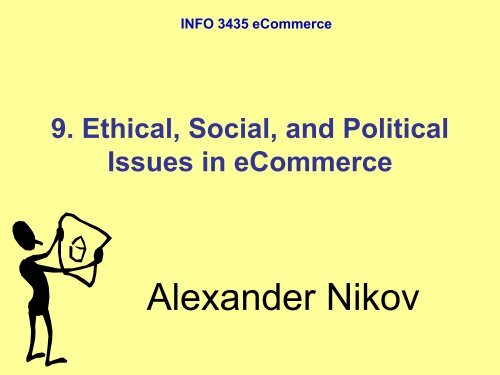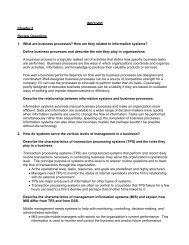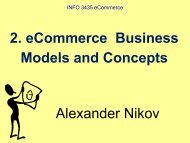Ethical, social, and political issues in e-Commerce
Ethical, social, and political issues in e-Commerce
Ethical, social, and political issues in e-Commerce
Create successful ePaper yourself
Turn your PDF publications into a flip-book with our unique Google optimized e-Paper software.
INFO 3435 e<strong>Commerce</strong>9. <strong>Ethical</strong>, Social, <strong>and</strong> PoliticalIssues <strong>in</strong> e<strong>Commerce</strong>Alex<strong>and</strong>er Nikov
Outl<strong>in</strong>e1. Underst<strong>and</strong><strong>in</strong>g <strong>Ethical</strong>, Social, <strong>and</strong> Political Issues <strong>in</strong> e<strong>Commerce</strong>2. Privacy <strong>and</strong> Information Rights3. Intellectual Property Rights4. Governance5. Public Safety <strong>and</strong> Welfare9-2
Teach<strong>in</strong>g Objectives• Expla<strong>in</strong> why e-commerce raises ethical, <strong>social</strong>, <strong>and</strong> <strong>political</strong> <strong>issues</strong>.• Identify the ma<strong>in</strong> ethical, <strong>social</strong>, <strong>and</strong> <strong>political</strong> <strong>issues</strong> raised by e-commerce.• Identify a process for analyz<strong>in</strong>g ethical dilemmas.• Expla<strong>in</strong> basic concepts related to privacy.• Identify the practices of e-commerce companies that threaten privacy.• Describe the different methods used to protect onl<strong>in</strong>e privacy.• Expla<strong>in</strong> the various forms of <strong>in</strong>tellectual property <strong>and</strong> the challenges<strong>in</strong>volved <strong>in</strong> protect<strong>in</strong>g it.• Expla<strong>in</strong> how the governance of the Internet has evolved over time.• Expla<strong>in</strong> why taxation of e-commerce raises governance <strong>and</strong> jurisdiction<strong>issues</strong>.• Identify major public safety <strong>and</strong> welfare <strong>issues</strong> raised by e-commerce9-3
Discover<strong>in</strong>g Law <strong>and</strong>Ethics <strong>in</strong> a Virtual WorldClass Discussion• Why is “mischief” <strong>in</strong> virtual worlds more difficult tostop? What constitutes mischief <strong>in</strong> Second Life?• Which behaviors have been banned <strong>in</strong> Second Life?• Is there a consensus regard<strong>in</strong>g whether or not <strong>in</strong>gamegambl<strong>in</strong>g <strong>and</strong> other virtual crimes are alsoactual crimes? What is Second Life’s stance?• How faithfully do you believe the law should beenforced <strong>in</strong> virtual worlds? 9-4
Outl<strong>in</strong>e1. Underst<strong>and</strong><strong>in</strong>g <strong>Ethical</strong>, Social, <strong>and</strong> Political Issues <strong>in</strong>e<strong>Commerce</strong>2. Privacy <strong>and</strong> Information Rights3. Intellectual Property Rights4. Governance5. Public Safety <strong>and</strong> Welfare9-5
Underst<strong>and</strong><strong>in</strong>g <strong>Ethical</strong>, Social, <strong>and</strong> PoliticalIssues <strong>in</strong> e<strong>Commerce</strong>• Internet, like other technologies, can:– Enable new crimes– Affect environment– Threaten <strong>social</strong> values• Costs <strong>and</strong> benefits must be carefully considered,especially when there are no clear-cut legal or culturalguidel<strong>in</strong>es9-6
9-7
A Model for Organiz<strong>in</strong>g the Issues• Issues raised by Internet <strong>and</strong> e-commerce can be viewedat <strong>in</strong>dividual, <strong>social</strong>, <strong>and</strong> <strong>political</strong> levels• Four major categories of <strong>issues</strong>:1. Information rights2. Property rights3. Governance4. Public safety <strong>and</strong> welfare9-8
The Moral Dimensions of an Internet SocietyFigure 8.1, Page 5009-9
• EthicsBasic <strong>Ethical</strong> Concepts– Study of pr<strong>in</strong>ciples used to determ<strong>in</strong>e right <strong>and</strong> wrong courses ofaction• Responsibility• Accountability• Liability– Laws permitt<strong>in</strong>g <strong>in</strong>dividuals to recover damages• Due process– Laws are known, understood– Ability to appeal to higher authorities to ensure laws appliedcorrectly9-10
Analyz<strong>in</strong>g <strong>Ethical</strong> Dilemmas• Process for analyz<strong>in</strong>g ethical dilemmas:– Identify <strong>and</strong> clearly describe the facts– Def<strong>in</strong>e the conflict or dilemma <strong>and</strong> identify thehigher-order values <strong>in</strong>volved– Identify the stakeholders– Identify the options that you can reasonably take– Identify the potential consequences of your options9-11
C<strong>and</strong>idate <strong>Ethical</strong> Pr<strong>in</strong>ciples• Golden Rule• Universalism• Slippery Slope• Collective Utilitarian Pr<strong>in</strong>ciple• Risk Aversion• No Free Lunch• The New York Times Test• The Social Contract Rule9-12
Outl<strong>in</strong>e1. Underst<strong>and</strong><strong>in</strong>g <strong>Ethical</strong>, Social, <strong>and</strong> Political Issues <strong>in</strong> e<strong>Commerce</strong>2. Privacy <strong>and</strong> Information Rights3. Intellectual Property Rights4. Governance5. Public Safety <strong>and</strong> Welfare9-13
Privacy <strong>and</strong> Information Rights• Privacy– Moral right of <strong>in</strong>dividuals to be left alone, free fromsurveillance or <strong>in</strong>terference from other <strong>in</strong>dividuals ororganizations• Information privacy– Subset of privacy– Includes both:• The claim that certa<strong>in</strong> <strong>in</strong>formation should not becollected at all• The claim of <strong>in</strong>dividuals to control the use of whatever<strong>in</strong>formation is collected about them9-14
Privacy <strong>and</strong> Information Rights• Major ethical issue related to e-commerce <strong>and</strong> privacy:– Under what conditions should we <strong>in</strong>vade privacy ofothers?• Major <strong>social</strong> issue:– Development of “expectations of privacy” <strong>and</strong> privacynorms• Major <strong>political</strong> issue:– Development of statutes that govern relationsbetween record keepers <strong>and</strong> <strong>in</strong>dividuals9-15
Information Collected at e<strong>Commerce</strong> Sites• Data collected <strong>in</strong>cludes– Personally identifiable <strong>in</strong>formation (PII)– Anonymous <strong>in</strong>formation• Types of data collected– Name, address, phone, e-mail, <strong>social</strong> security– Bank <strong>and</strong> credit accounts, gender, age, occupation,education– Preference data, transaction data, clickstream data,browser type9-16
9-17
9-18
9-19
Social Networks <strong>and</strong> Privacy• Social networks– Encourage shar<strong>in</strong>g personal details– Pose unique challenge to ma<strong>in</strong>ta<strong>in</strong><strong>in</strong>g privacy• Facebook’s facial recognition technology <strong>and</strong> tagg<strong>in</strong>g• Personal control over personal <strong>in</strong>formation vs.organization’s desire to monetize <strong>social</strong> network9-20
Mobile <strong>and</strong> Location-based Privacy Issues• Smartphone apps– Funnel personal <strong>in</strong>formation to mobile advertisers fortarget<strong>in</strong>g ads– Track <strong>and</strong> store user locations• 42% of users say privacy a concern• Mobile Device Privacy Act– Not yet passed– Requires <strong>in</strong>form<strong>in</strong>g consumers about data collection9-21
Profil<strong>in</strong>g <strong>and</strong> Behavioral Target<strong>in</strong>g• Profil<strong>in</strong>g– Creation of digital images that characterize onl<strong>in</strong>e <strong>in</strong>dividual <strong>and</strong>group behavior– Anonymous profiles– Personal profiles• Advertis<strong>in</strong>g networks– Track consumer <strong>and</strong> brows<strong>in</strong>g behavior on Web– Dynamically adjust what user sees on screen– Build <strong>and</strong> refresh profiles of consumers• Google’s AdWord program9-22
Profil<strong>in</strong>g <strong>and</strong> Behavioral Target<strong>in</strong>g• Deep packet <strong>in</strong>spection• Bus<strong>in</strong>ess perspective:– Increases effectiveness of advertis<strong>in</strong>g, subsidiz<strong>in</strong>gfree content– Enables sens<strong>in</strong>g of dem<strong>and</strong> for new products <strong>and</strong>services• Critics’ perspective:– Underm<strong>in</strong>es expectation of anonymity <strong>and</strong> privacy– Consumers show significant opposition tounregulated collection of personal <strong>in</strong>formation9-23
Internet <strong>and</strong> Government Invasions of Privacy• Various laws strengthen ability of law enforcementagencies to monitor Internet users without knowledge<strong>and</strong> sometimes without judicial oversight– CALEA, PATRIOT Act, Cyber Security EnhancementAct, Homel<strong>and</strong> Security Act• Government agencies are largest users of private sectorcommercial data brokers• Retention by ISPs of user data a concern9-24
Legal Protections• In the United States, explicitly granted or derived from– Constitution• First Amendment—guarantees freedom of speech<strong>and</strong> association• Fourth Amendment—protects aga<strong>in</strong>stunreasonable search <strong>and</strong> seizure• Fourteenth Amendment—guarantees due process– Specific statutes <strong>and</strong> regulations (federal <strong>and</strong> state)– Common law9-25
9-26
9-27
9-28
Informed Consent• U.S. firms can gather <strong>and</strong> redistribute transaction<strong>in</strong>formation without <strong>in</strong>dividual’s <strong>in</strong>formed consent– Illegal <strong>in</strong> Europe• Informed consent:– Opt-<strong>in</strong>– Opt-out– Many U.S. e-commerce firms merely publish<strong>in</strong>formation practices as part of privacy policy withoutprovid<strong>in</strong>g for any form of <strong>in</strong>formed consent9-29
The FTC’s Evolv<strong>in</strong>g Privacy Approach• Fair Information Practice pr<strong>in</strong>ciples (1998)– Notice– Choice– Access– Security– Enforcement– Restricted collection• New privacy framework (2010)– Privacy by design– Simplified choice– Greater transparency9-30
FTC’s Fair Information Practice Pr<strong>in</strong>ciplesNotice/AwarenessChoice/ConsentAccess/ParticipationSecurityEnforcementSites must disclose <strong>in</strong>formation practices before collect<strong>in</strong>g data.Includes identification of collector, uses of data, other recipients of data,nature of collection (active/<strong>in</strong>active), voluntary or required,consequences of refusal, <strong>and</strong> steps taken to protect confidentiality,<strong>in</strong>tegrity, <strong>and</strong> quality of the dataThere must be a choice regime <strong>in</strong> place allow<strong>in</strong>g consumers to choosehow their <strong>in</strong>formation will be used for secondary purposes other thansupport<strong>in</strong>g the transaction, <strong>in</strong>clud<strong>in</strong>g <strong>in</strong>ternal use <strong>and</strong> transfer to thirdparties. Opt-<strong>in</strong>/Opt-out must be available.Consumers should be able to review <strong>and</strong> contest the accuracy <strong>and</strong>completeness of data collected about them <strong>in</strong> a timely, <strong>in</strong>expensiveprocess.Data collectors must take reasonable steps to assure that consumer<strong>in</strong>formation is accurate <strong>and</strong> secure from unauthorized use.There must be <strong>in</strong> place a mechanism to enforce FIPpr<strong>in</strong>ciples. This can <strong>in</strong>volve self-regulation, legislation giv<strong>in</strong>g consumerslegal remedies for violations, or federal statutes <strong>and</strong> regulation.SOURCE: Based on data from Federal Trade Commission, 1998, 2000a.9-31
FTC Recommendations: Onl<strong>in</strong>e Profil<strong>in</strong>gPr<strong>in</strong>cipleNoticeChoiceAccessSecurityEnforcementRestrictedCollectionRecommendationComplete transparency to user by provid<strong>in</strong>g disclosure <strong>and</strong> choiceoptions on the host Web site. “Robust” notice for PII (time/place ofcollection; before collection beg<strong>in</strong>s). Clear <strong>and</strong> conspicuous noticefor non-PII.Opt-<strong>in</strong> for PII, opt-out for non-PII. No conversion of non-PII to PIIwithout consent. Opt-out from any or all network advertisers froma s<strong>in</strong>gle page provided by the host Web site.Reasonable provisions to allow <strong>in</strong>spection <strong>and</strong> correction.Reasonable efforts to secure <strong>in</strong>formation from loss, misuse, orimproper access.Done by <strong>in</strong>dependent third parties, such as seal programs <strong>and</strong>account<strong>in</strong>g firms.Advertis<strong>in</strong>g networks will not collect <strong>in</strong>formation about sensitivef<strong>in</strong>ancial or medical topics, sexual behavior or sexual orientation,or use Social Security numbers for profil<strong>in</strong>g.9-32
The European Directive on Data Protection• Privacy protection much stronger <strong>in</strong> Europe than theUnited States• European approach:– Comprehensive <strong>and</strong> regulatory <strong>in</strong> nature• European Commission’s Directive on Data Protection(1998):– St<strong>and</strong>ardizes <strong>and</strong> broadens privacy protection <strong>in</strong> European Unioncountries• Department of <strong>Commerce</strong> safe harbor program:– For U.S. firms that wish to comply with Directive9-33
Private Industry Self-Regulation• Safe harbor programs:– Private, self-regulat<strong>in</strong>g policy <strong>and</strong> enforcement mechanism thatmeets objectives of government regulations <strong>and</strong> legislation, but doesnot <strong>in</strong>volve government regulation or enforcement– E.g., privacy seal programs (TRUSTe, BBB Reliability Seal)• Industry associations <strong>in</strong>clude:– Onl<strong>in</strong>e Privacy Alliance (OPA)– Network Advertis<strong>in</strong>g Initiative (NAI)• CLEAR Ad Notice Technical Specifications• Privacy advocacy groups– E.g., Epic.org• Emerg<strong>in</strong>g privacy protection bus<strong>in</strong>ess9-34
• Spyware• Pop-up blockers• Secure e-mail• Anonymous remailers, surf<strong>in</strong>g• Cookie managers• Disk/file eras<strong>in</strong>g programs• Policy generators• Public key encryptionTechnological Solutions• Privacy Policy Reader/Platform for Privacy Preferences (P3P):– Comprehensive technological privacy protection st<strong>and</strong>ard– Works through user’s Web browser– Communicates a Web site’s privacy policy• Compares site policy to user’s preferences or to other st<strong>and</strong>ardssuch as FTC’s FIP guidel<strong>in</strong>es or EU’s Data Protection Directive9-35
9-36
9-37
How P3P WorksFigure 8.2(A), Page 522SOURCE: W3C Platform for Privacy Preferences Initiative, 2003.9-38
Internet explorer 9’s <strong>and</strong> Google ChromeImplementation of P3P9-39
Outl<strong>in</strong>e1. Underst<strong>and</strong><strong>in</strong>g <strong>Ethical</strong>, Social, <strong>and</strong> Political Issues <strong>in</strong> e<strong>Commerce</strong>2. Privacy <strong>and</strong> Information Rights3. Intellectual Property Rights4. Governance5. Public Safety <strong>and</strong> Welfare9-40
Intellectual Property Rights• Intellectual property:– Encompasses all tangible <strong>and</strong> <strong>in</strong>tangible products of human m<strong>in</strong>d• Major ethical issue:– How should we treat property that belongs to others?• Major <strong>social</strong> issue:– Is there cont<strong>in</strong>ued value <strong>in</strong> protect<strong>in</strong>g <strong>in</strong>tellectual property <strong>in</strong> theInternet age?• Major <strong>political</strong> issue:– How can Internet <strong>and</strong> e-commerce be regulated or governed toprotect <strong>in</strong>tellectual property?9-41
Intellectual Property Protection• Three ma<strong>in</strong> types of protection:1. Copyright2. Patent3. Trademark law• Goal of <strong>in</strong>tellectual property law:– Balance two compet<strong>in</strong>g <strong>in</strong>terests—public <strong>and</strong> private• Ma<strong>in</strong>ta<strong>in</strong><strong>in</strong>g this balance of <strong>in</strong>terests is always challengedby the <strong>in</strong>vention of new technologies9-42
Copyright• Copyright law:– Protects orig<strong>in</strong>al forms of expression (but not ideas) from be<strong>in</strong>gcopied by others for a period of time• Look <strong>and</strong> feel copyright <strong>in</strong>fr<strong>in</strong>gement lawsuits• Fair use doctr<strong>in</strong>e• Digital Millennium Copyright Act, 1998– First major effort to adjust copyright laws to Internet age– Implements WIPO treaty that makes it illegal to make, distribute,or use devices that circumvent technology-based protections ofcopyrighted materials9-43
9-44
9-45
Patents• Grant owner 20-year monopoly on ideas beh<strong>in</strong>dan <strong>in</strong>vention– Mach<strong>in</strong>es– Man-made products– Compositions of matter– Process<strong>in</strong>g methods• Invention must be new, non-obvious, novel• Encourages <strong>in</strong>ventors• Promotes dissem<strong>in</strong>ation of new techniquesthrough licens<strong>in</strong>g• Stifles competition by rais<strong>in</strong>g barriers to entry9-46
e<strong>Commerce</strong> Patents• 1998 State Street Bank & Trust vs. SignatureF<strong>in</strong>ancial Group– Bus<strong>in</strong>ess method patents• Most European patent laws do not recognizebus<strong>in</strong>ess methods unless based on technology• Examples– Amazon’s one-click purchas<strong>in</strong>g– DoubleClick’s dynamic delivery of onl<strong>in</strong>e advertis<strong>in</strong>g9-47
Internet <strong>and</strong> e<strong>Commerce</strong>Bus<strong>in</strong>ess Method PatentsFigure 8.2, Page 538SOURCE: U.S. Patent <strong>and</strong> Trademark Office, 2010.9-48
9-49
9-50
Trademarks• Identify, dist<strong>in</strong>guish goods, <strong>and</strong> <strong>in</strong>dicate theirsource• Purpose– Ensure consumer gets what is paid for/expected to receive– Protect owner aga<strong>in</strong>st piracy <strong>and</strong> misappropriation• Infr<strong>in</strong>gement– Market confusion– Bad faith• Dilution– Behavior that weakens connection between trademark <strong>and</strong> product9-51
Trademarks <strong>and</strong> the Internet• Cybersquatt<strong>in</strong>g– Anticybersquatt<strong>in</strong>g Consumer Protection Act (ACPA)• Cyberpiracy– Typosquatt<strong>in</strong>g• Metatagg<strong>in</strong>g• Keyword<strong>in</strong>g• Deep l<strong>in</strong>k<strong>in</strong>g• Fram<strong>in</strong>g9-52
9-53
Outl<strong>in</strong>e1. Underst<strong>and</strong><strong>in</strong>g <strong>Ethical</strong>, Social, <strong>and</strong> Political Issues <strong>in</strong> e<strong>Commerce</strong>2. Privacy <strong>and</strong> Information Rights3. Intellectual Property Rights4. Governance5. Public Safety <strong>and</strong> Welfare9-54
Governance• Primary questions– Who will control Internet <strong>and</strong> e-commerce?– What elements will be controlled <strong>and</strong> how?• Stages of governance <strong>and</strong> e-commerce– Government Control Period (1970–1994)– Privatization (1995–1998)– Self-Regulation (1995–present)– Government Regulation (1998–present)9-55
9-56
Who Governs e<strong>Commerce</strong> <strong>and</strong> the Internet?• Currently: mixed mode policy environment– Self-regulation, through variety of Internet policy <strong>and</strong>technical bodies, co-exists with limited governmentregulation• ICANN <strong>in</strong> charge of Doma<strong>in</strong> Name System• Internet can be very easily controlled, monitored, <strong>and</strong>regulated from a central location (e.g., Ch<strong>in</strong>a, S<strong>in</strong>gapore,etc.)9-57
Taxation• E-commerce taxation illustrates complexity of governance<strong>and</strong> jurisdiction <strong>issues</strong>• U.S. sales taxed by states <strong>and</strong> local government• MOTO retail<strong>in</strong>g• E-commerce benefits from tax “subsidy”• October 2007: Congress extends tax moratorium for anadditional seven years• Unlikely that comprehensive, <strong>in</strong>tegrated rational approach totaxation issue will be determ<strong>in</strong>ed for some time to come9-58
Net Neutrality• Neutrality: All Internet traffic treatedequally—all activities charged the same rate, no preferentialassignment of b<strong>and</strong>width• Backbone providers vs. content providers• December 2010 FCC approved “compromise” net neutralityrules• Telecom providers adopt<strong>in</strong>g compromise position betweenwired <strong>and</strong> mobile wireless access9-59
Outl<strong>in</strong>e1. Underst<strong>and</strong><strong>in</strong>g <strong>Ethical</strong>, Social, <strong>and</strong> Political Issues <strong>in</strong> e<strong>Commerce</strong>2. Privacy <strong>and</strong> Information Rights3. Intellectual Property Rights4. Governance5. Public Safety <strong>and</strong> Welfare9-60
Public Safety <strong>and</strong> Welfare• Protection of children <strong>and</strong> strong sentiments aga<strong>in</strong>stpornography– Pass<strong>in</strong>g legislation that will survive court challenges hasproved difficult• Efforts to control gambl<strong>in</strong>g <strong>and</strong> restrict sales of drugs <strong>and</strong>cigarettes– Currently mostly regulated by state law– Unlawful Internet Gambl<strong>in</strong>g Enforcement Act9-61
















